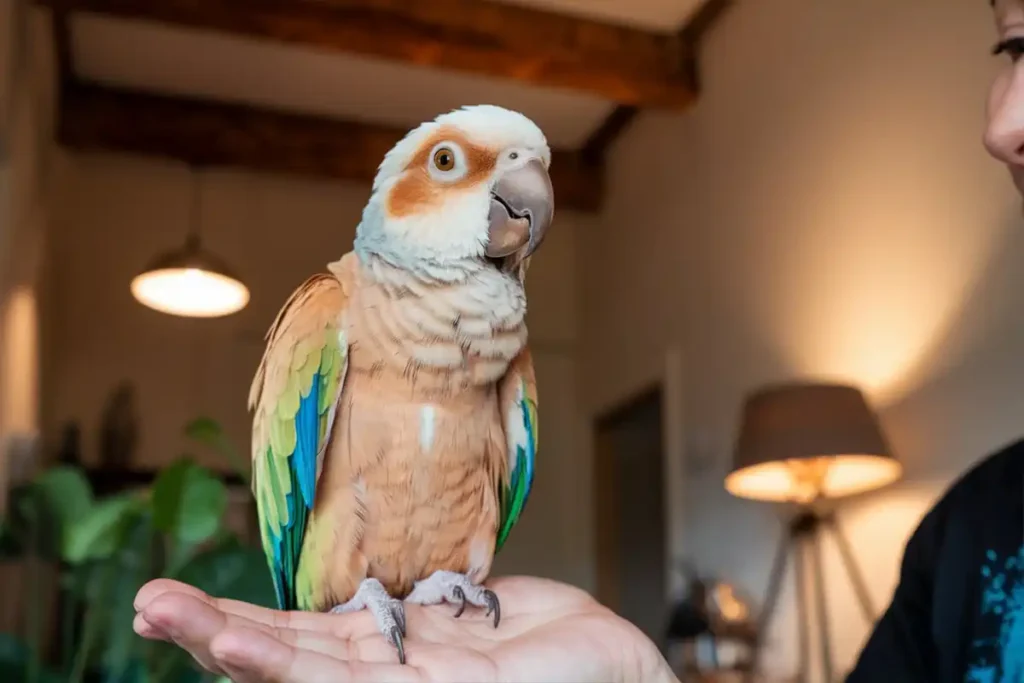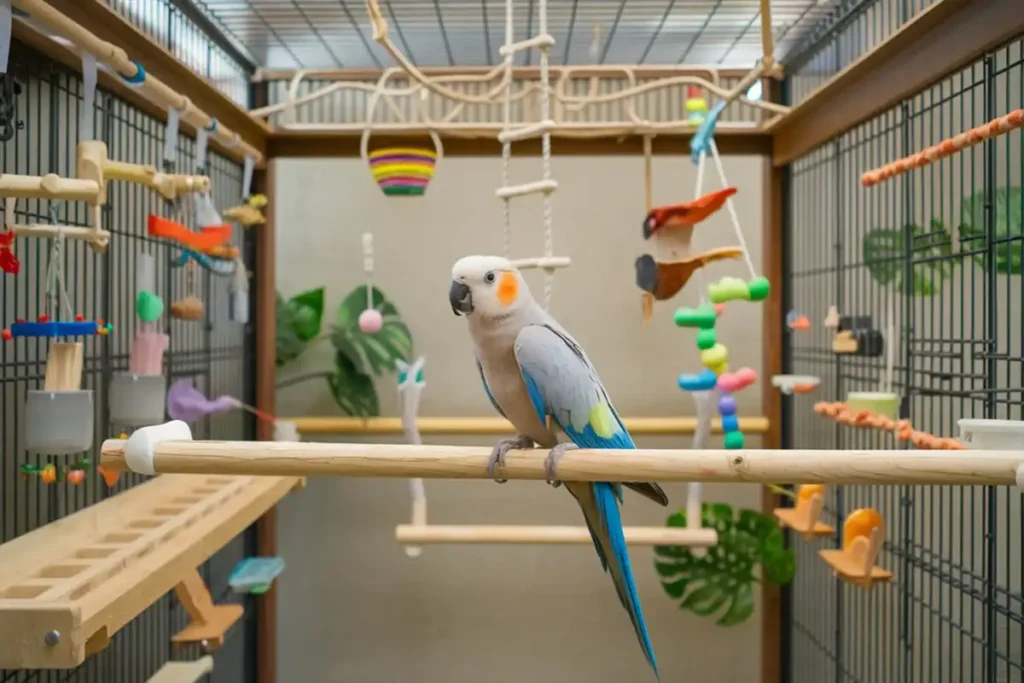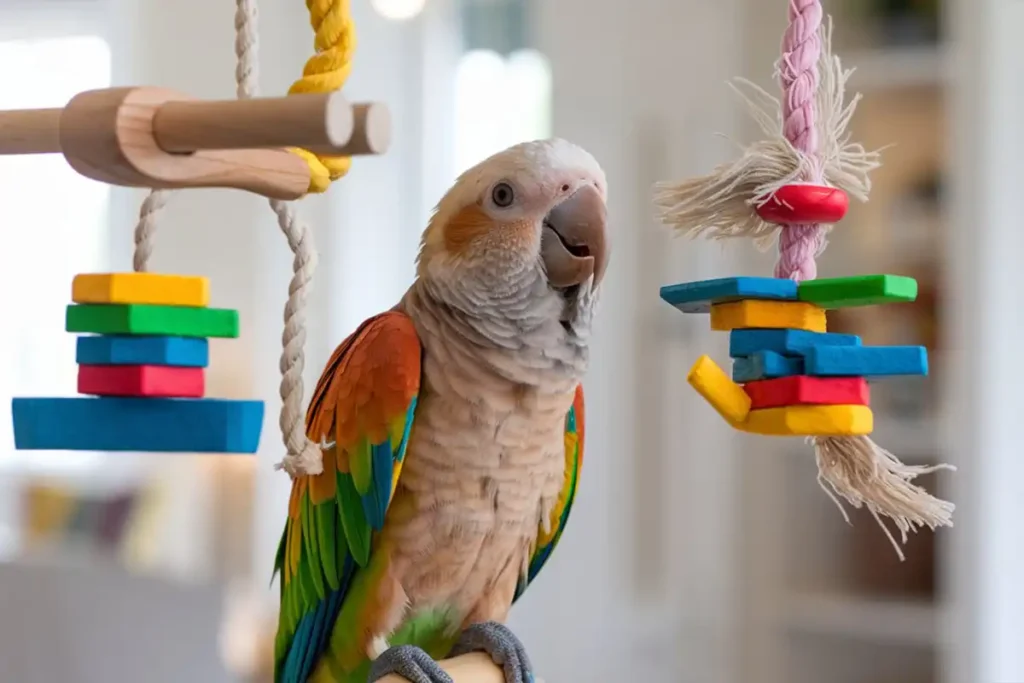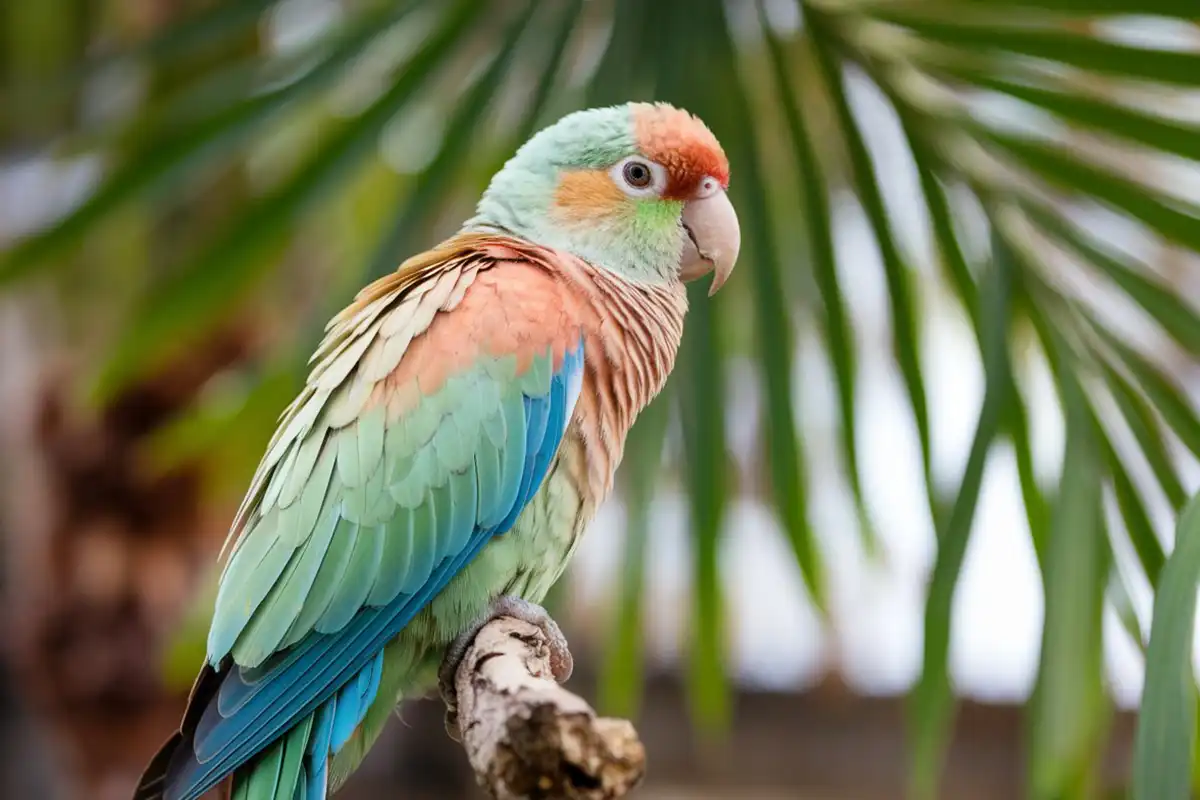If you’re searching for a pet that’s intelligent, affectionate, and full of personality, the Cinnamon Quaker Parrot might be your perfect match. This charming variation of the classic Quaker Parrot—also known as the Monk Parakeet—stands out with its warm cinnamon and green feathers, cheerful demeanor, and remarkable ability to mimic sounds and speech. Families and bird lovers alike adore this bird not only for its beauty but also for its engaging, social nature.
Raising a Cinnamon Quaker means welcoming a curious and lively companion into your home—one that thrives on interaction and quickly bonds with its human flock. With the right care, a stimulating environment, and a little patience, these parrots flourish in loving households. In this guide, we’ll explore everything you need to know about Cinnamon Quaker Parrots, from their unique personality and care needs to creating the ideal habitat and ensuring a long, healthy life.
Meet the Cinnamon Quaker Parrot
What Makes the Cinnamon Quaker Unique?
The Cinnamon Quaker Parrot brings a special blend of visual appeal and personality that few other pet birds can match. Its soft, cinnamon-brown feathers paired with shades of light green give it a warm and inviting look, perfect for anyone who wants a bird that stands out. Beyond appearances, this parrot is known for its exceptional intelligence and sociable nature.
It loves to engage with people, mimic sounds, and even pick up words and phrases with consistent interaction. Owners quickly learn how responsive and affectionate these birds can be. The Cinnamon Quaker Parrot thrives on daily attention, making it a perfect choice for families or individuals looking for a loyal and entertaining companion that truly feels like part of the household.
Difference Between Cinnamon Quakers and Other Quaker Parrot Colors
Quaker parrots come in a variety of color mutations, each with its own charm. The most common color is green, followed by popular mutations like blue, yellow, and albino. However, the Cinnamon Quaker Parrot holds a unique place among them due to its soft brown and light green hues that give it a more subdued, earthy appearance. This coloring creates a peaceful, almost pastel-like look that contrasts beautifully with the brighter shades of its cousins.
While all Quakers share similar traits—like being intelligent, playful, and talkative—the cinnamon variety often appeals to owners who want a bird with both a calm aesthetic and a lively personality. The Cinnamon Quaker Parrot blends beauty and behavior in a way that truly sets it apart from other color variations.
Origins and Species: Monk Parakeet and the Psittacidae Family
The Cinnamon Quaker Parrot is a color mutation of the Monk Parakeet, scientifically named Myiopsitta monachus.Monk Parakeets come from Argentina and other areas in South America. They are famous for living in groups and making big, detailed nests. These parrots are special. Many parrots live alone or in small groups, but these parrots live together in big groups. They can live happily in towns and also out in the country.
These birds belong to the Psittacidae family, a group that includes some of the most intelligent parrots in the world. Through selective breeding, aviculturists developed the cinnamon mutation, which gives the Cinnamon Quaker Parrot its distinctive coloring while maintaining the species’ curious and affectionate personality. Despite their exotic roots, Cinnamon Quakers adapt well to domestic life, forming strong bonds with their humans and becoming treasured members of the family.
Cinnamon Quaker Lifespan and What to Expect
Choosing a Cinnamon Quaker Parrot means making a long-term commitment, as these birds can live for 20 to 30 years when properly cared for. With such a lengthy lifespan, it’s important to understand the responsibility involved in providing a stable and loving environment throughout their life. These parrots need consistent social interaction, mental stimulation, and a balanced diet to stay happy and healthy over the years.
They can form deep emotional connections with their owners, often becoming deeply attached to one or two people in particular. To keep your Cinnamon Quaker Parrot thriving, schedule regular avian vet checkups, rotate stimulating toys, and maintain a routine that supports both physical and emotional well-being. With love and care, they will reward you with years of loyalty and playful companionship.
Understanding the Cinnamon Quaker Personality
Affectionate and Friendly: Ideal for Loving Homes
The Cinnamon Quaker Parrot shines as one of the most affectionate and friendly pet birds available. It naturally gravitates toward human interaction and thrives in households where it receives daily attention and affection. These parrots love to perch on shoulders, cuddle close, and even preen their favorite humans as a sign of trust. They enjoy being part of the family routine and often seek involvement in daily activities like mealtime or relaxing in front of the TV.
Their loyal, affectionate nature makes them perfect for loving homes, especially those with children or adults who enjoy companionship. With the Cinnamon Quaker Parrot, you’re not just getting a pet—you’re inviting a feathered friend into your heart and daily life.

Talking Abilities and Mimicking Behavior of a Talking Quaker Parrot
One of the most entertaining traits of the Cinnamon Quaker Parrot is its impressive ability to mimic speech and household sounds. These parrots have a natural talent for picking up words, phrases, and even entire short sentences with regular interaction and repetition. They mimic doorbells, ringtones, and familiar voices, often surprising owners with their timing and accuracy.
A well-socialized Cinnamon Quaker Parrot will often greet you with phrases it has learned and can carry on simple “conversations” that feel playful and personal. While not all individuals talk equally well, most Cinnamon Quakers develop a rich vocal range that adds another layer of fun to their personality. With patience and practice, your feathered friend can become quite the talkative companion.
Quaker Parrot Behavior: Social, Smart, and Sometimes Sassy
Don’t let their size fool you—Cinnamon Quaker Parrots pack big personalities into their small bodies. These birds are highly social and intelligent, always eager to interact, solve puzzles, and learn new things. Their curiosity leads them to explore their environment constantly, often getting into playful mischief.
You’ll notice moments of sass, like foot-stomping or “chattering” when something doesn’t go their way, which only adds to their charm. They enjoy mental challenges and love toys that make them think, such as foraging puzzles and interactive games. The Cinnamon Quaker Parrot keeps things lively in any home, balancing sweet affection with just the right amount of cheeky personality to keep their humans laughing and engaged every day.
How to Bond with a Tame Bird Using Positive Reinforcement Training
Building a strong bond with your Cinnamon Quaker Parrot starts with trust and consistency. These birds respond extremely well to positive reinforcement training, which uses rewards like praise, treats, or gentle attention to encourage good behavior. First, practice for only a short time. Make it easy. Find a quiet room or area. There should be no noise or things to look at. Reward your parrot for stepping onto your hand, mimicking a sound, or even just staying calm during handling.
Over time, your Cinnamon Quaker Parrot will associate you with safety, fun, and love—leading to a stronger emotional connection. This training method also helps reduce unwanted behaviors and builds confidence in shy birds. With daily interaction and patience, you’ll create a deep, rewarding bond that turns your parrot into a loyal and loving lifelong companion.
Cinnamon Quaker Parrot Care Essentials
Quaker Parrot Diet: Seed and Pellet Diet Basics
Feeding your Cinnamon Quaker Parrot a balanced diet is one of the most important steps toward ensuring a long, healthy life. While seeds are a part of their natural diet, they should only make up a small portion of what you offer daily. High-quality parrot pellets provide essential nutrients that seeds alone can’t supply. Pellets should form the foundation of their meals, with a moderate amount of seeds offered occasionally as a treat or training reward.
Always provide fresh, clean water and monitor your bird’s weight and energy levels. A proper diet supports a strong immune system, vibrant feather quality, and overall wellness. A well-fed Cinnamon Quaker Parrot stays active, alert, and ready to engage with its environment and human companions.

Bird-Safe Fruits and Vegetables to Include
Fresh fruits and vegetables play a crucial role in the daily nutrition of a Cinnamon Quaker Parrot. These natural foods add variety, essential vitamins, and hydration to their diet. You can safely offer options like apples (without seeds), bananas, carrots, leafy greens, broccoli, berries, and sweet potatoes. Rotate these daily to keep your bird interested and to expose them to a range of nutrients.
Always wash produce thoroughly and avoid anything treated with pesticides. Never feed avocados, chocolate, onions, garlic, or fruit seeds, as these can be toxic. The Cinnamon Quaker Parrot enjoys colorful, crunchy, and juicy foods, so make feeding time fun by offering chopped produce in food puzzles or hanging treat clips inside the cage for mental stimulation.
Importance of Regular Veterinary Avian Care
Just like dogs and cats, Cinnamon Quaker Parrots need routine health checkups to thrive. Avian veterinarians specialize in bird care and can detect early signs of illness before they become serious. Schedule an annual exam to monitor your bird’s weight, beak, feathers, and droppings, all of which offer clues about internal health.
Your vet can also offer guidance on diet, behavior changes, and grooming tips. Since birds often hide symptoms until they’re very ill, regular vet visits are crucial for prevention. A healthy Cinnamon Quaker Parrot shows bright eyes, smooth feathers, and active, vocal behavior. Prioritizing veterinary care helps your feathered friend stay happy, live longer, and enjoy life as a cherished member of your family.
Keeping Your Bird Mentally Stimulated with Parrot Toys
Mental stimulation is just as important as physical health for your Cinnamon Quaker Parrot. Without regular enrichment, intelligent birds like Quakers can become bored, anxious, or even destructive. Keep your parrot engaged by offering a variety of parrot toys designed to challenge their mind and satisfy their natural curiosity.
Give your pet toys to find food in. Also give food puzzle toys, ropes, bells, and things to tear, like paper or soft wood. These things are very helpful. They make the pet use its brain and move around. Rotate toys regularly to maintain excitement and prevent boredom. You can even create DIY toys using bird-safe materials like cardboard, untreated wood, and paper. A mentally stimulated Cinnamon Quaker Parrot is happier, more affectionate, and less likely to develop behavioral issues. Daily playtime and variety go a long way in supporting a well-rounded, joyful life.
Ideal Parrot Cage Setup and Environment
Choosing the Right Cage Size for Your Cinnamon Quaker
Your Cinnamon Quaker Parrot needs a spacious, secure cage to thrive both physically and mentally. The ideal cage should measure at least 18x18x18 inches, but bigger is always better—especially if your parrot spends a lot of time indoors. Horizontal bars are important, as Quakers love to climb and explore.
Make sure the bar spacing is no wider than 5/8 inch to prevent injury or escape. Your bird should be able to flap its wings, stretch, and move around freely without feeling cramped. The right cage creates a safe zone for rest, play, and eating. A well-sized home gives your Cinnamon Quaker Parrot room to live comfortably and helps reduce stress, boredom, and behavior issues caused by confinement.

Must-Have Avian Cage Accessories (Perches, Swings, Ladders)
Creating an enriching home environment for your Cinnamon Quaker Parrot starts with adding the right accessories. Start with natural wood perches of varying thicknesses to support healthy feet and exercise. Add swings for fun movement and ladders for climbing and exploration. Include toys that promote chewing, foraging, and problem-solving to prevent boredom and boost mental activity.
Avoid plastic perches or sandpaper-covered ones, as they can cause foot irritation. Place perches at different heights and avoid crowding the cage to allow free movement. The right accessories turn a basic cage into a dynamic, stimulating space that keeps your Cinnamon Quaker Parrot active, happy, and well-adjusted to daily life indoors.
Setting Up a Safe and Engaging Parrot Perch Area
Your Cinnamon Quaker Parrot spends a lot of time on its perches, so setting up a safe and comfortable perch area is essential. Use natural wood perches like manzanita, dragonwood, or cholla, which help trim nails and offer good grip. Avoid smooth plastic or sandpaper perches, which can hurt their feet over time.
Offer multiple perch styles in different thicknesses and textures to promote healthy foot muscles. Place them in both the upper and lower cage areas to encourage movement. Make sure perches aren’t directly above food or water bowls to avoid contamination. A well-designed perch setup gives your Cinnamon Quaker Parrot a place to play, relax, and feel secure in its environment.
Tips for Creating a Calm, Enriching Living Space
A calm, enriching environment plays a huge role in your Cinnamon Quaker Parrot’s overall well-being. Place the cage in a quiet but active part of your home, where your parrot can see you but won’t be overwhelmed by constant noise or traffic. Keep the area free of drafts, direct sunlight, and fumes from the kitchen or cleaning products.
Add soft background sounds like gentle music or nature recordings to create a peaceful atmosphere. Rotate toys regularly to keep things fresh, and offer daily out-of-cage time for extra stimulation. The more balanced and predictable the environment, the more secure your Cinnamon Quaker Parrot will feel—leading to better behavior, stronger bonding, and a happier, healthier life.
Tips for Raising a Happy and Healthy Cinnamon Quaker Parrot
Socialization Tips for Friendly Pet Birds
Socializing your Cinnamon Quaker Parrot from an early age helps build trust and encourages a confident, well-adjusted bird. Start by spending quiet, consistent time near your parrot’s cage so it becomes familiar with your presence. Talk gently, offer treats through the bars, and respect its pace. Once comfortable, introduce hand-feeding and step-up training to deepen the bond.
Let your parrot experience new sights and sounds in a controlled way—move its cage around occasionally, introduce it to different people, and offer safe, supervised out-of-cage time. Avoid overwhelming or forcing interactions. A well-socialized Cinnamon Quaker Parrot becomes more curious, affectionate, and less prone to fear or aggression, making it a joyful and interactive companion for the whole family.

Training Techniques Using Positive Reinforcement
Training your Cinnamon Quaker Parrot using positive reinforcement sets the foundation for a respectful and trusting relationship. Begin with short, consistent training sessions, using favorite treats and verbal praise to reward desired behavior. Teach basic commands like “step up,” “stay,” or even fun tricks like waving or turning in a circle. Always stay calm, patient, and encouraging—never punish mistakes.
Parrots learn best through repetition and positive experiences. Use clicker training if you want to mark precise actions, and gradually increase challenges as your bird gains confidence. Positive reinforcement builds communication, strengthens your bond, and helps curb unwanted behaviors. Over time, your Cinnamon Quaker Parrot will not only obey commands—it will enjoy learning and interacting with you daily.
Common Health Issues and How to Prevent Them
Like all parrots, the Cinnamon Quaker Parrot can face health problems if its care needs aren’t fully met. Common issues include feather plucking, obesity, vitamin deficiencies, and respiratory infections. Prevent these problems by offering a balanced diet rich in pellets, fresh produce, and clean water. Keep the cage clean and well-ventilated, and provide daily mental stimulation to prevent boredom-related behaviors.
Avoid exposure to non-stick cookware fumes, cigarette smoke, or strong cleaning chemicals, which can harm your bird’s lungs. Schedule annual checkups with an avian vet to catch early signs of illness. A healthy Cinnamon Quaker Parrot displays smooth feathers, bright eyes, active behavior, and a strong appetite—signs that you’re providing the care it needs to thrive.
Long-Term Care Tips to Extend Your Cinnamon Quaker’s Lifespan
To help your Cinnamon Quaker Parrot live a long, fulfilling life, focus on consistent long-term care from day one. Maintain a balanced diet with high-quality pellets, bird-safe fruits and vegetables, and occasional seeds. Offer a variety of toys and out-of-cage time daily to keep your bird mentally sharp and physically active.
Build a strong bond through regular social interaction and training, which supports emotional well-being. Keep the living space calm, clean, and safe from potential hazards like toxic plants or fumes. Most importantly, schedule annual avian vet visits to track health and prevent issues. With love, structure, and proper care, your Cinnamon Quaker Parrot can remain a lively, affectionate, and healthy member of your family for decades.
Conclusion
Bringing a Cinnamon Quaker Parrot into your home means adding a burst of personality, intelligence, and affection to your daily life. These charming birds stand out not only for their warm, cinnamon-hued feathers but also for their playful spirit and deep desire to bond with their humans. They thrive in loving homes where they receive consistent attention, mental stimulation, and positive interaction.
The Cinnamon Quaker Parrot quickly becomes more than just a pet—it becomes a true companion. Its talking ability, entertaining behavior, and emotional intelligence make it a favorite among bird enthusiasts of all ages. It doesn’t matter if this is your first bird, or if you have owned parrots for a long time, this parrot adapts well to patient, caring environments.
To give your Cinnamon Quaker Parrot the best life possible, focus on balanced nutrition, daily enrichment, proper socialization, and regular veterinary care. Provide a spacious cage filled with fun accessories and rotate toys often to keep your bird mentally engaged. Build trust through positive reinforcement training and meaningful, hands-on bonding time.
If you’re ready to invest in a long-lasting, joyful relationship with a feathered friend, the Cinnamon Quaker Parrot is an ideal choice. With the right care and commitment, this delightful bird will fill your home with laughter, love, and unforgettable memories for many years to come.
You Can Read more about This Bird “Quaker Parrot” in This Article.
Learn More about Pets and Adoption From HERE!
Find Some Good stuff for your Pet On Pet MD Official
